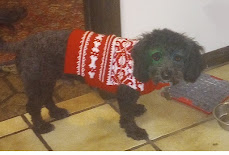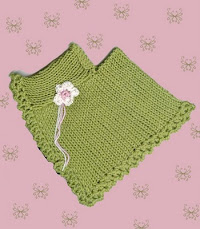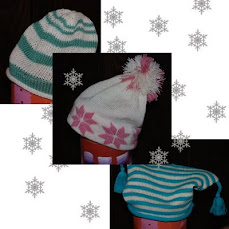
Although I don't walk the dog as much as I probably should, I do get out in all kinds of weather. She needs to be on a leash, so I thought I'd do up some felted fingerless mitts to get the job done easily--- for my paws, that is. They turned out pretty nice and I know they'll be warm. I used worsted weight wool on the midgauge machine. Before felting them, I embroidered some flourishes with loose stitches as an experiment. At worst, I thought, they'll pucker up around the embroidery and at best, the embroidery would kind of sit on top of or sink into the rest of the top of the mitt. The later turned out to be the case. So, I'm pretty satisfied with them.
The dawg in question is our Gertie, aka Queen of Holland, as she is called by the hubby. She does look like she's smiling, happy to be on the blog, doesn't she?
 She's a Keeshond, pronounced KAZE hund. Did a little research on her breed and found lots of info from the American Kennel Club and other places. The Keeshond was named after the 18th-century Dutch patriot, Cornelis (Kees) de Gyselaer, leader of the Dutch rebellion against the House of Orange. The dog became the rebels' symbol, and when the House of Orange was returned to power, this wonderful breed almost disappeared. The word 'keeshond' is a compound word: 'Kees' is a nickname for Cornelius (de Gyselaer), and 'hond' is a Dutch word for dog. In Holland, "keeshond" is the term for German Spitzes that encompass them all from the toy or dwarf (Pomeranian) to the Wolfsspitz (Keeshond). The sole difference between the German Spitzes is their coloring and size guidelines. You might see them referred to as "The Smiling Dutchman".
She's a Keeshond, pronounced KAZE hund. Did a little research on her breed and found lots of info from the American Kennel Club and other places. The Keeshond was named after the 18th-century Dutch patriot, Cornelis (Kees) de Gyselaer, leader of the Dutch rebellion against the House of Orange. The dog became the rebels' symbol, and when the House of Orange was returned to power, this wonderful breed almost disappeared. The word 'keeshond' is a compound word: 'Kees' is a nickname for Cornelius (de Gyselaer), and 'hond' is a Dutch word for dog. In Holland, "keeshond" is the term for German Spitzes that encompass them all from the toy or dwarf (Pomeranian) to the Wolfsspitz (Keeshond). The sole difference between the German Spitzes is their coloring and size guidelines. You might see them referred to as "The Smiling Dutchman". Another, less popular story, is that way back-originally the breed is the result of a cross between a wolf and a chow chow, in China, a thousand years ago. Who knows? The more widely accepted version is that the Keeshond was developed from the northern sleigh dogs of the Arctic. These spitz type dogs have been around in Holland for hundreds of years. They are believed to have come from Vikings. A legend tells of a Viking ship which sank, with only the captain's son surviving. He was rescued by a Christian fisherman of northern Holland and his dog. The fisherman, the rescuee and the dog all landed on a foreign land and built a chapel to St. Olaf out of gratefulness for finding land. From here a village was built near the Amstel River, which later led to a dam being built. This dam led to the name of the town becoming Amstelredam, which is now currently Amsterdam. Today, the seal of the city shows a ship with a spitz type dog looking over the side of it. Because of this story and other legends, taking a dog on board a ship became good luck. The breed then served as dogs accompanying people to sea on boats and barges, and became known as the Dutch Barge Dog. (Our Gertie HATES water. Bathtub, lake, whatever. She thinks I'm torturing her if I give her a bath. Do you suppose they were bred to NOT jump off the barge into the water?)


First Registered by the AKC: 1930
AKC Group: Non-Sporting
Class: Non-Sporting
Registries: AKC, ANKC, CKC, FCI (Group 5), KC (GB), UKC
Keeshonden tend to be very playful, (Gertie is a stand up comedian) with quick reflexes and strong jumping ability. (At dinner time, she invariably jumps about a foot off the floor to see what's on the stove top for dinner! Never gets close to it, just wants to see what's cookin'.) They are quick learners and eager to please. Because Keeshonden are quick learners, they also learn the things you didn't necessarily wish to teach them - very quickly. However, Keeshonden make excellent agility and obedience dogs. So amenable to proper training is this bright, sturdy dog that Keeshonden have been successfully trained to serve as guide dogs for the blind; only their lack of size has prevented them from being more widely used in this role.
They love children and are excellent family dogs, preferring to be close to their humans whenever possible. They generally get along with other dogs as well and will enjoy a good chase around the yard. Keeshonden are very intuitive and empathic and are often used as comfort dogs. Most notably, at least one Keeshond, Tikva, was at Ground Zero on 9/11 to help comfort the rescue workers. I read an article that said "Tikva" means "hope". The breed has a tendency to become especially clingy towards their owners, even in comparison to other dogs. If their owner is out, or in another room behind a closed door, they may sit, waiting for their owner to reappear, even if there are other people nearby. Many have been referred to as their "owner's shadow," or "velcro dogs".
I don't know about velcro, but this dog is more of a yarn dog. If she were human---she would be a knitter.

Probably a machine knitter. She loves yarn. Being kind of a yarn snob, she loves wool. I have to be careful not to leave any skeins of yarn or cones of yarn within her reach.




We got Gertie from a breeder in Kansas last summer as a 6 month old pup. She was destined to be a show dog like her parents, but the breeder said she had a bit of an underbite, which would cause points to be knocked off her score. O well, so much for glory. She is a beauty anyway and definitely the queen of our household.




































































No comments:
Post a Comment